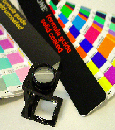
WORKING WITH
C O L O U R
C O L O U R
When preparing artwork special consideration has to be paid to use of colour. The price of short run colour printing has dropped considerably over the past few years with the introduction of digital print. Increased mechanisation has also brought the cost of full colour litho down. Obviously single and two colour printing is still far cheaper but it is quite likely that if you are preparing artwork for print, at sometime you will be producing artwork for a colour section.
Red, Green and Blue are the colours used to create colours on computers and digital cameras. A large spectrum of colours are available and they tend to be brighter than their equivalent CMYK versions. When producing artwork from RGB images these must be converted to CMYK before printing and the colour match checked.
Cyan, Magenta, Yellow and Black are the four colours used to create print on both digital and litho machines. A smaller spectrum of colours is available and it is sometimes not possible to match a colour very closely, dark blues, greens and oranges tend to be the most problematic colours.
SPOT COLOUR
This is the term used to describe any none CMYK offset printing. Each colour is printed from a separate printing plate. The artwork is ‘separated’ electronically and a film separation is produced for each colour required.
A swatch containing colour samples and recipes for 1,000 colours is produced by Pantone. The 12 most popular colours are available for no extra charge, a £6 charge is made for mixing other colours. Most applications include Pantone spot colours within their palettes. Do not rely upon the screen colour being an accurate representation of the colour. If in doubt consult a Pantone chart. We have several at the print works and you are more than welcome to look at them. The chart is split into 2 sections, coated and uncoated. The colour will be very different on the two different stocks, this has to be taken into consideration when selecting colours.
ARTWORK PREPARATION
CMYK FOR LITHO OR DIGITAL
CMYK artwork preparation is fairly straight forward. It is important to check the colour match on a Pantone CMYK chart if a close match is an issue. We have a chart at the print works which you are more than welcome to consult. It is always advisable to use solid colours for small text to maintain clarity where possible. This can be 100C, M, Y or K or of course red from 100M & 100Y, green from 100C & 100Y or a dark violet/blue from 100C & 100M. Very pale tints don’t tend to reproduce very well, try to stick to at least 10% minimum on each individual colour.
Remember that large solids of black should be mixed with 25%C to give a rich dense black. Try to avoid TAC values of more than 225 especially where folding is involved because the toner/ink may crack.
If the file is being converted to PDF it is essential to embed fonts, include crop and registration marks and enable a 3mm bleed.
If an exact colour match is essential or a colour is not available in the CMYK spectrum it is sometimes necessary to produce a CMYK + spot job. Special care must be taken when producing the artwork.
SINGLE COLOUR LITHO
When preparing artwork for a single colour job on litho always produce the artwork in black and specify the required ink colour when ordering. If the job is to be printed on an uncoated stock always brighten any bitmap images slightly to compensate for the slight dot gain which may occur. Areas of tints over 50% should be avoided on uncoated stock. Make sure that text is 100% black or 100%K, often imported text from MS programs comes through as an RGB colour and will reproduce as a tint unless adjusted.
It is always best to convert colour images to greyscale and adjust the brightness and contrast if necessary.
SPOT COLOUR LITHO
Producing artwork for a multi spot colour job for litho is slightly tricky. It is essential to use a software package that supports spot colour separation. Care must be taken that no other colour other than the 2 or 3 pantone colours required by the job exist within the document. If converting the file to PDF it is essential to embed fonts, include crop and registration marks and enable a 3mm bleed.


